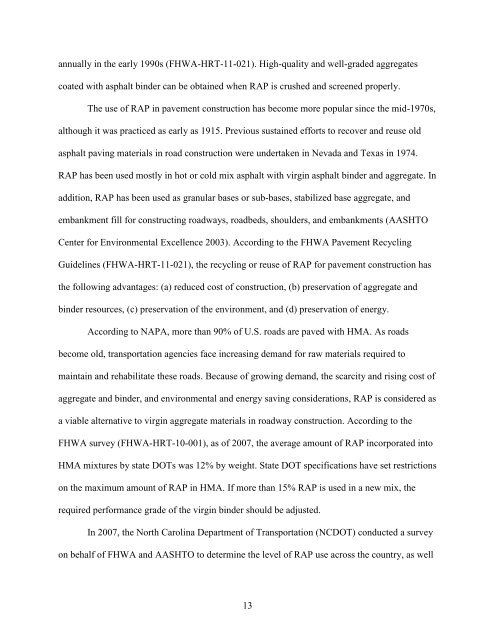Onsite Use of Recycled Asphalt Pavement Materials and Geocells to ...
Onsite Use of Recycled Asphalt Pavement Materials and Geocells to ...
Onsite Use of Recycled Asphalt Pavement Materials and Geocells to ...
You also want an ePaper? Increase the reach of your titles
YUMPU automatically turns print PDFs into web optimized ePapers that Google loves.
annually in the early 1990s (FHWA-HRT-11-021). High-quality <strong>and</strong> well-graded aggregates<br />
coated with asphalt binder can be obtained when RAP is crushed <strong>and</strong> screened properly.<br />
The use <strong>of</strong> RAP in pavement construction has become more popular since the mid-1970s,<br />
although it was practiced as early as 1915. Previous sustained efforts <strong>to</strong> recover <strong>and</strong> reuse old<br />
asphalt paving materials in road construction were undertaken in Nevada <strong>and</strong> Texas in 1974.<br />
RAP has been used mostly in hot or cold mix asphalt with virgin asphalt binder <strong>and</strong> aggregate. In<br />
addition, RAP has been used as granular bases or sub-bases, stabilized base aggregate, <strong>and</strong><br />
embankment fill for constructing roadways, roadbeds, shoulders, <strong>and</strong> embankments (AASHTO<br />
Center for Environmental Excellence 2003). According <strong>to</strong> the FHWA <strong>Pavement</strong> Recycling<br />
Guidelines (FHWA-HRT-11-021), the recycling or reuse <strong>of</strong> RAP for pavement construction has<br />
the following advantages: (a) reduced cost <strong>of</strong> construction, (b) preservation <strong>of</strong> aggregate <strong>and</strong><br />
binder resources, (c) preservation <strong>of</strong> the environment, <strong>and</strong> (d) preservation <strong>of</strong> energy.<br />
According <strong>to</strong> NAPA, more than 90% <strong>of</strong> U.S. roads are paved with HMA. As roads<br />
become old, transportation agencies face increasing dem<strong>and</strong> for raw materials required <strong>to</strong><br />
maintain <strong>and</strong> rehabilitate these roads. Because <strong>of</strong> growing dem<strong>and</strong>, the scarcity <strong>and</strong> rising cost <strong>of</strong><br />
aggregate <strong>and</strong> binder, <strong>and</strong> environmental <strong>and</strong> energy saving considerations, RAP is considered as<br />
a viable alternative <strong>to</strong> virgin aggregate materials in roadway construction. According <strong>to</strong> the<br />
FHWA survey (FHWA-HRT-10-001), as <strong>of</strong> 2007, the average amount <strong>of</strong> RAP incorporated in<strong>to</strong><br />
HMA mixtures by state DOTs was 12% by weight. State DOT specifications have set restrictions<br />
on the maximum amount <strong>of</strong> RAP in HMA. If more than 15% RAP is used in a new mix, the<br />
required performance grade <strong>of</strong> the virgin binder should be adjusted.<br />
In 2007, the North Carolina Department <strong>of</strong> Transportation (NCDOT) conducted a survey<br />
on behalf <strong>of</strong> FHWA <strong>and</strong> AASHTO <strong>to</strong> determine the level <strong>of</strong> RAP use across the country, as well<br />
13
















